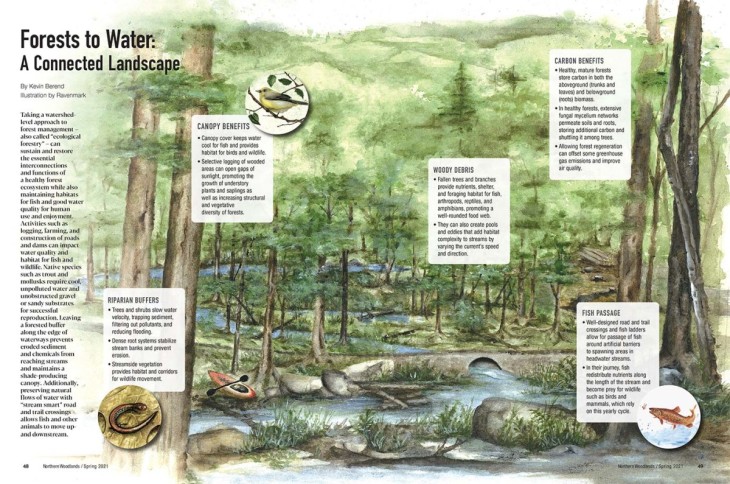
Taking a watershed-level approach to forest management – also called “ecological forestry” – can sustain and restore the essential interconnections and functions of a healthy forest ecosystem while also maintaining habitats for fish and good water quality for human use and enjoyment. Activities such as logging, farming, and construction of roads and dams can impact water quality and habitat for fish and wildlife. Native species such as trout and mollusks require cool, unpolluted water and unobstructed gravel or sandy substrates for successful reproduction. Leaving a forested buffer along the edge of waterways prevents eroded sediment and chemicals from reaching streams and maintains a shade-producing canopy. Additionally, preserving natural flows of water with “stream smart” road and trail crossings allows fish and other animals to move up and downstream.
CANOPY BENEFITS
- Canopy cover keeps water cool for fish and provides habitat for birds and wildlife.
- Selective logging of wooded areas can open gaps of sunlight, promoting the growth of understory plants and saplings as well as increasing structural and vegetative diversity of forests.
RIPARIAN BUFFERS
- Trees and shrubs slow water velocity, trapping sediment, filtering out pollutants, and reducing flooding.
- Dense root systems stabilize stream banks and prevent erosion.
- Streamside vegetation provides habitat and corridors for wildlife movement.
CARBON BENEFITS
- Healthy, mature forests store carbon in both the aboveground (trunks and leaves) and belowground (roots) biomass.
- In healthy forests, extensive fungal mycelium networks permeate soils and roots, storing additional carbon and shuttling it among trees.
- Allowing forest regeneration can offset some greenhouse gas emissions and improve air quality.
WOODY DEBRIS
- Fallen trees and branches provide nutrients, shelter, and foraging habitat for fish, arthropods, reptiles, and amphibians, promoting a well-rounded food web.
- They can also create pools and eddies that add habitat complexity to streams by varying the current’s speed and direction.
FISH PASSAGE
- Well-designed road and trail crossings and fish ladders allow for passage of fish around artificial barriers to spawning areas in headwater streams.
- In their journey, fish redistribute nutrients along the length of the stream and become prey for wildlife such as birds and mammals, which rely on this yearly cycle.
This infographic and the accompanying article, At Chapman Brook, were made possible by grants from The Betterment Fund and Maine Timberlands Charitable Trust.

